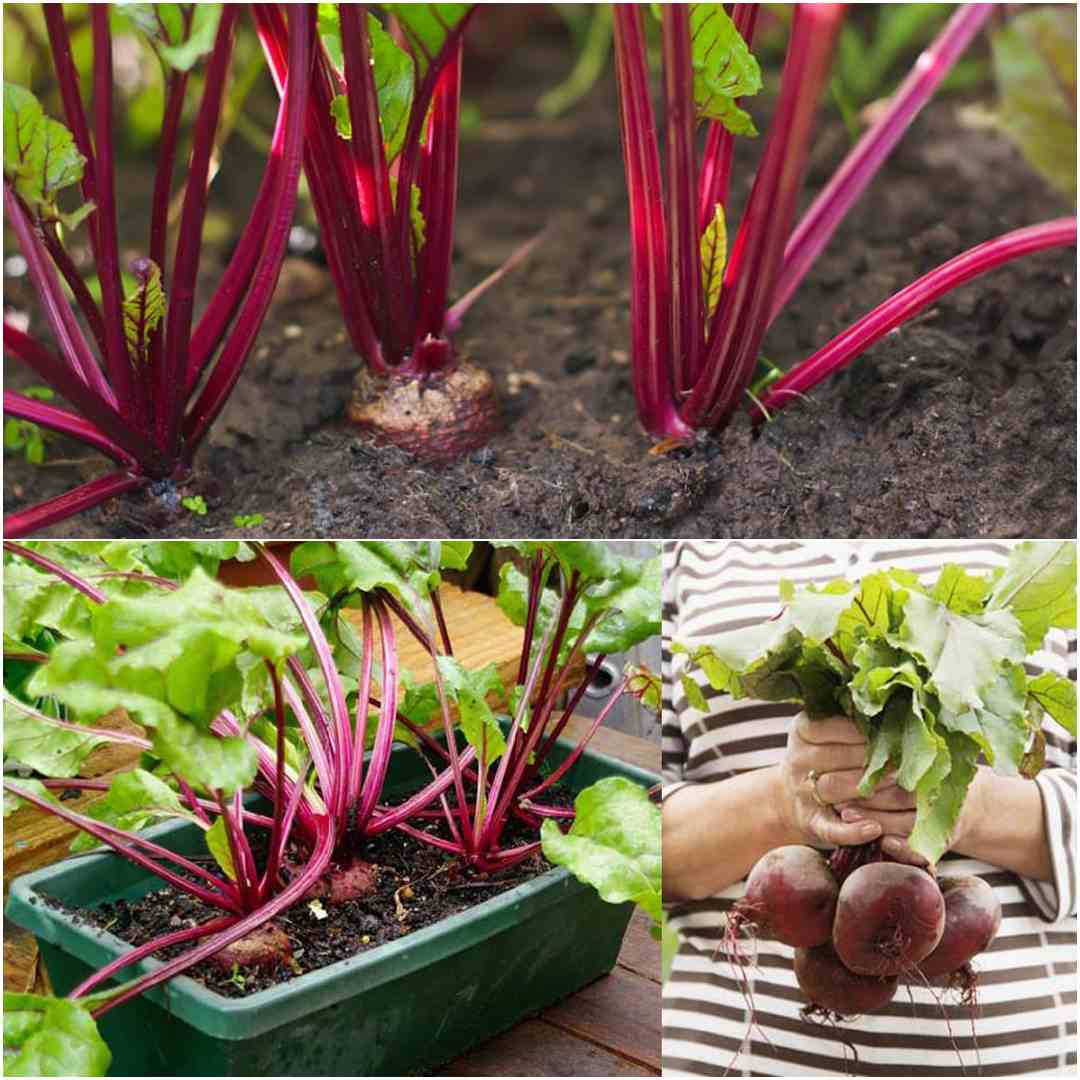Grow beets for both their vibrant, sweet roots and nutritious leafy greens, making them an excellent choice for beginner and experienced gardeners alike. Whether you’re planting beets for their versatility or simply to enjoy their colorful presence in the garden, this dual-purpose crop thrives in various conditions. In this guide, I’ll walk you through how to grow beets, from planting to harvesting, so you can savor their delicious flavors and vibrant colors. Beets are not only easy to grow but also offer numerous culinary possibilities, from salads to soups, and even pickling!
How to Grow Beets: The Ultimate Guide for Gardeners
If you’re wondering how to grow beets, this article covers everything you need to know. Beets are a cool-season crop that thrives in both spring and fall, and they grow quickly, making them ideal for gardeners looking for fast results. Whether you’re aiming to enjoy their roots, greens, or both, here’s how you can successfully grow beets at home.
Planting Site for Beets
Choosing the Best Location for Beets
The first thing to consider when growing beets is selecting the right spot in your garden. Beets need a location with full sun, meaning they should get at least 6 hours of direct sunlight per day. If you choose a spot with partial shade, you’ll likely end up with more greens than roots, which is not ideal if you’re planting beet seeds primarily for their tasty bulbs.
Preparing the Soil for Beets
Beets grow best in well-prepared soil that’s fertile and loose. The roots need room to expand, so make sure the soil is free of rocks and debris. Beets prefer soil with a pH between 6.0 and 7.0, which is slightly acidic to neutral. If your soil is too acidic (pH below 6.0), you might want to add some lime to balance it out.
For how to grow beets successfully, it’s important to till the soil before planting beet seeds, ensuring it’s well-drained and rich in organic matter. Beets are quite tolerant of average soil, but improving fertility will always lead to bigger and tastier roots.
When to Plant Beets
Best Time to Start Planting Beets
To get the timing right for how to plant beets, you’ll want to start early in the season. Begin planting your first round of beet seeds in early spring, as soon as the soil is workable. Beets are frost-hardy and can handle a light freeze, so you don’t need to wait for the last frost date to pass.
Successive Planting for a Continuous Harvest
If you want a continuous harvest of beets, try successive plantings. Sow beet seeds every 2 to 3 weeks from early spring through mid-summer. This way, you’ll always have a fresh crop maturing at different times. Keep in mind that once temperatures rise above 75°F (24°C), beet roots may struggle to develop properly. For fall planting, start sowing your seeds from mid-summer through early fall, about 4 to 6 weeks before the first frost.
Growing Beets in Warmer Zones
In warmer USDA Zones like Zone 9 or above, beets can be grown as a winter crop. Plant your beets in early to late fall, and enjoy a winter harvest. Since beets are frost-tolerant, they’ll thrive in cooler winter temperatures, providing you with fresh produce even during the colder months.
How to Plant Beets
Direct Sowing in the Garden
The best way to grow beets is by sowing the seeds directly in your garden. Beets don’t like having their roots disturbed, but they can tolerate transplanting when they’re young. Here’s how to plant beet seeds for the best results:
- Sow seeds ½-inch deep and 1 to 2 inches apart in rows that are about 12 to 18 inches apart.
- Cover the seeds with a thin layer of soil.
- Soak the seeds for 24 hours before planting to speed up germination, especially in areas with low moisture.
- Water the soil consistently to keep it moist but not waterlogged.
Since beet seeds are technically clusters containing 2 to 4 seeds, you may notice several seedlings sprouting from one spot. Don’t worry, you’ll thin them later to make room for the strongest plants.
Transplanting Beets
If you’ve started your beets indoors or in a seed tray, you can transplant them once they’re a few inches tall. Be careful not to disturb the roots too much. Transplanted beets might not grow as large, but they can still produce good-sized roots.
Growing Beets: Key Tips for Success
Thinning Beet Plants
As your beet seedlings grow, you’ll need to thin them out to ensure the remaining plants have enough room. When the greens reach 4 to 5 inches tall, thin them to 3 to 4 inches apart. You can eat the greens you thin out—beet greens are delicious and highly nutritious.
A key tip for how to grow beets successfully is to snip off the extra plants at the soil line rather than pulling them out, which can disturb the roots of neighboring plants.
Watering and Mulching
Beets need consistent moisture to grow well. Aim to water your beet patch with about 1 inch of water per square foot per week. Mulching the soil can help retain moisture, keep the roots cool, and prevent weeds from taking over.
Fertilizing Beets
Beets don’t typically need much fertilizer if you’ve enriched the soil before planting. However, if you decide to fertilize, avoid using too much nitrogen. Too much nitrogen will lead to lush, leafy greens but smaller beet roots. Focus on a balanced fertilizer or one higher in phosphorus and potassium for root development.
Pest and Disease Prevention
To prevent pests and diseases from ruining your beet crop, consider using row covers. Common pests that affect beets include flea beetles, leaf miners, and leafhoppers. To successfully grow beets, it’s important to be aware of these threats. Beets can also suffer from diseases like cercospora leaf spot and cucumber mosaic virus. Use proper crop rotation and avoid overhead watering to reduce the risk of these issues as you learn to grow beets successfully.
Types of Beets: Varieties to Grow
There’s a wide range of beet varieties, each offering unique colors, flavors, and shapes. Whether you’re a fan of classic red beets or more unusual colors, here are some popular varieties:
Red Beets
- ‘Detroit Dark Red’: A traditional round, deep red beet that’s perfect for all purposes.
- ‘Chioggia’: Known for its red and white concentric rings, this beet is a showstopper when sliced.
Yellow Beets
- ‘Touchstone Gold’: A bright yellow variety that’s sweet and mild in flavor.
- ‘Bolder’: Another yellow beet that produces large, flavorful roots.
White Beets
- ‘Avalanche’: A white beet that’s sweeter than most red varieties, with a crisp texture.
- ‘Albino’: A Dutch heirloom variety known for its smooth, white roots.
Cylindrical Beets
- ‘Formanova’: This long, cylindrical beet is perfect for slicing and canning, growing more like a carrot than a traditional beetroot.
Harvesting Beets
When to Harvest Beets
Beets are ready for harvest between 55 to 70 days after planting, depending on the variety. Harvest them when the roots are the size of a golf ball to a tennis ball. If you let them grow too large, the roots may become woody and tough.
To harvest beets, loosen the soil around the root and gently pull it out. Be sure to harvest the greens as well—they can be picked throughout the growing season and cooked like spinach.
Storing Beets
Once harvested, fresh beets can be stored in the refrigerator for 5 to 7 days. For longer storage, you can keep beets in a cool, dry place, such as a root cellar. Simply brush off the soil and layer them in dry sand or sawdust to prevent sprouting.
Beets can also be preserved by freezing, canning, or pickling. You can even freeze beet greens to use at a later time!
Pests and Diseases of Beets
Common Beet Pests
- Flea Beetles: These tiny pests leave small holes in beet leaves. Using row covers can help keep them at bay.
- Leaf Miners: These pests tunnel through leaves, leaving visible trails. Remove infested leaves as soon as possible.
Common Beet Diseases
- Cercospora Leaf Spot: This fungal disease causes brown spots with purple halos. Avoid overhead watering and ensure proper air circulation to prevent it.
- Cucumber Mosaic Virus: This virus causes mottled leaves and stunted growth. Control aphids, as they are the primary carriers.
Neem oil, sulfur, and other organic fungicides can also be used to manage pest and disease issues.
Growing Beets Is Easy and Rewarding
Growing beets is not only easy, but it’s also incredibly rewarding. From their vibrant roots to their nutritious greens, beets are a versatile crop that can be used in a variety of dishes. Whether you’re a seasoned gardener or just starting out, knowing how to grow beets will give you a reliable harvest every season. When you learn how to grow beets, you can enjoy their unique flavors and health benefits. Follow these tips on planting, growing, and caring for beets, and you’ll soon enjoy a bounty of beautiful, delicious beets from your garden.
FAQs
How long do beets take to grow?
Beets typically take between 55 to 70 days to grow beets, depending on the variety. You can start harvesting when the roots are about the size of a golf ball, although you can let them grow a bit larger if you prefer.
How do you grow beets for beginners?
For beginners, grow beets is simple. Direct sow the seeds in well-prepared soil that’s loose and free of rocks. Make sure they get full sun, water them consistently, and thin the seedlings once they sprout to give the roots space to develop.
How many beets do you get from one plant?
Each beet seed produces one beetroot. Since beet seeds are actually clusters, you may see multiple seedlings sprouting, but you’ll need to thin them to one plant per space to ensure healthy root development when you grow beets.
Are beets hard to grow?
No, beets are considered easy to grow beets and are perfect for beginners. As long as you provide the right conditions—loose soil, adequate sunlight, and consistent moisture—they will thrive.


